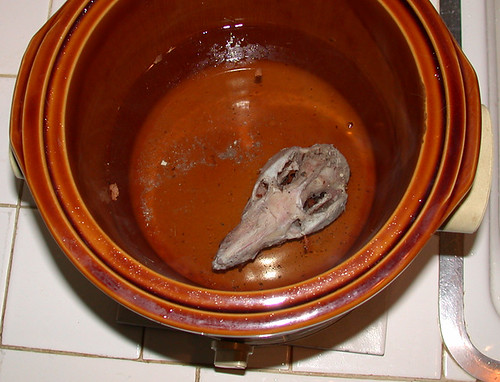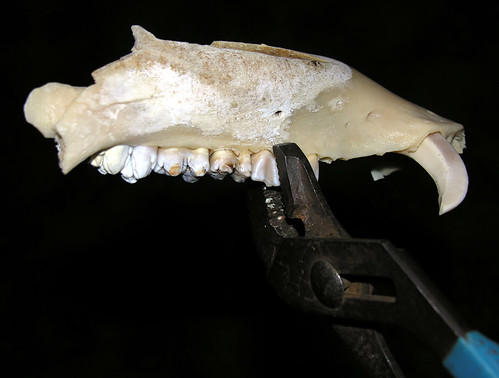I've mentioned here previously in my 'Bad Words: BOIL & BLEACH' post that my last resort for removing tough stuck on ligaments, skin and etc from bones is a crock pot. But I didn't really go into much detail. So this is my instructional guide for that.
This crock pot method is one of my own invention. I've never met anyone else that does it. It has worked well for me since the early 90s when I first started using it. I've further mastered it since and figured out other ways to use it for bone processing tasks... and I've used the same trusty crock pot all these years.
DEFLESHING:
When I have a really stuck on flesh mass, ligaments or something similar that maceration has not removed I use the crock pot as a last resort to remove it from the bone. Most of the time it works within hours but in tough cases I've had to leave it overnight or a full 24 hours.
I like to add a metal veggie steamer/strainer to the bottom of the crock pot to minimize the bones/teeth actually touching the hot ceramic pot since it is this extreme heat that can damage them. But if you can find a metal strainer that fits in your crock pot that won't rust, that will work well too.
This method is also a good way to carefully clean smaller more fragile bones that may start to break down during maceration. Put them in a metal screen style tea strainer if they are that small to keep from losing them, or another smaller metal strainer that will fit into the crock pot.
The reason I do this in a crock pot and not stove top is because I like to carefully regulate the temperature. Stove top simmering always seems to eventually boil. The lowest setting on my crock pot never boils. I've discussed why boiling bones is bad in my 'Bad Words: BOIL & BLEACH' post.
I fill the crock pot with water well above the bone and put it on low and replace the lid. Being sure to top off the water as it evaporates. Best part is that there is nothing to do. You just put your bones into the crock pot and go do something else. Just like when you use it to cook dinner.

Vultures had literally just pulled the outer skin off this opossum so I decided to do a slow simmer in the crock pot instead of maceration. This worked very quickly with the flesh still so fresh/soft.
There's really not much of a need to add anything to the water. The slow constant heat alone will get the toughest dried on mummified skin off of anything. Often overnight. Sometimes I pour out what has cooked off overnight, add new water and start again... if it is something really fleshy like a mummified head.

These turtle skulls started off whole mummified heads before I added them to the crock pot. The process is so gentle that even the keratin sheaths (or rhamphotheca) that covers the upper and lower turtles jaws were unharmed.
DEGREASING:
If the bones seem very greasy I just add a little dish soap to the water and it helps the natural fats out of the bone and rise to the top. That's the only additive I've ever put in the water with the bones. But grease will still come out of the bone without you even adding soap to the water! This is why I say to add water well above the top of the bones you've added to the crock pot. The grease will float to the top where you can easily spoon it out of the water.

These partial coyote skulls were quite visibly greasy so I put them in the crock pot overnight with some dish soap.

The next morning a good amount of grease was at the top of the water.

To easily remove the grease from the crock pot so it doesn't get back onto the skulls when removing them I just scooped it out with a spoon. Doesn't get any easier than that. Remember as I discussed previously in my post 'Bad Words: BOIL & BLEACH' that boiling bone will draw the grease further inside the bone. So don't do that to remove the natural fats in animal remains.
SOFTENING BONE TO REMOVE TEETH:
Another thing I use the crock pot for it to soften bone so that it is easier for me to remove teeth. This worked well for these wild boar mandible fragments.
The bone became soft enough after a couple days for me to use pliers and wrenches to carefully smash and break the mandible apart and extract the teeth.

Much more about this at my 'Extracting Teeth From Bone' blog post.
My crock pot method works beautifully. Very low maintenance. Rarely any need to scrub anything from the bones afterwords. I've never even had any need to find another method. I do wish though that crock pots came MUCH LARGER...haha
I hope you enjoy my HowTo blog posts. For most of the time I've been collecting and processing bones the internet was not yet around and this info was not commonly found in books either. So I've had over 30 years of trial and error figuring out these things on my own. I decided to save everyone some time that comes across my blog and let them in on a few of my trade secrets. And hopefully keep some bones from being destroyed in the process.

hi! i'm new at this stuff, so i have a few questions for you if you have the time :)
ReplyDelete1: how do i preserve insects?
2: when you're in the woods collecting stuff, are you ever worried about bumping into a dangerous animal? when i'm in the woods i'm always scared to meet a brown bear or something that would attack me. (i live in sweden)
3: should i wear gloves when i touch bones or dead animals?
hoping for some answers :) love what you do by the way!
Hi Lina!
ReplyDelete1) I find all of my insects already dead and there is very little to do to preserve them. Here in Florida they quickly naturally dry out on their own. I do not kill insects and mount them.
2) There are no dangerous animals where I am other than some rattlesnakes. Just be very aware of your surroundings at all times and travel with a partner while bone collecting if it is a concern.
3) Yes, always wear gloves while handling anything dead. Sun bleached bones are usually ok to pick up with your bare hands though. And wash your hands well after doing any bone processing. I usually take a shower and change clothes if I've done anything exceptionally messy.
Good luck and have fun!
Hi there! I am also painfully new at this. I have a quail head that still has feathers and flesh on it, although i believe the blood is drained. I have never cleaned flesh or feather from bone before, but I desperately want that cute little quail skull. What should I do?
ReplyDeleteVery Informative! This blog is great source of information which is very useful for me. Thank you very much for sharing this!
ReplyDeleteOffice Cleaning
This might sound gross but is it safe to use the crock pot for food after using it for this? (Yes, I know I'd have to wash it.) I'm on a bit of a budget but this sounds exactly like what I need.
ReplyDeleteCallum - That honestly sounds like a very bad idea, washed or not. I can't stress enough to keep your regular kitchen/bathroom items apart from your bone processing items. You may just want to macerate and be patient instead. Stay safe!
ReplyDeleteI figured as much. Luckily I found a cheap crock pot on craigslist. I've already macerated my raccoon but there are some stubborn bits, so I'll use this method. Thanks!
ReplyDeleteSo, I have a problem. I have a lot of goose heads and feet in my freezer that I'd really like to clean up, but I live in a situation where I have no outdoors to long term macerate my bones and I don't want to leave anything stinky in my apartment for my roommate to deal with (or our cats).
ReplyDeleteI also saw Jake's Bones post about the baby bottle warmer, but I don't think they still make the one he has, they only make a much smaller version that I don't think will work for even a goose skull.
Will the Crock Pot method you describe here work for general maceration so that I don't have to worry too much about not having an outdoor area in which to do my macerations?
Any advice would be greatly appreciated.
- MEKS
Hi Tsimmu!
ReplyDeleteI recently processed a whole duck & it involved outdoor bone cage decomp, then maceration, then peroxide. turned out beautifully. A duck (or goose) beak & skull are quite thin and fragile & would most likely be destroyed if cooked in any way. No bird bones of any kind would likely survive in a crockpot. If you can find a very tight fitted plastic container you can hide somewhere inside/outside I highly suggest macerating them that way. There will be zero smell even inside if you use a high quality container w/tight lid.
Good luck
jana
I found some whale bones the other day I was wanting to turn into jewelry. The bones are from a 3 week rotted whale carcass that was beached nearby. What would you recommend? The bones are from the fin of the whale and are only about 6in by 3in.
ReplyDeleteI came across some whale bones the other day from a 3week old rotted humpback whale. I would like to make some whale carved necklaces and I was hoping you would have some advice on how to clean the bones. They are from the fin of the whale and are only about as big as a remote for a TV. PS: I extracted them from the carcass and they are smelly :(
ReplyDeleteThat's an amazing and unusual find Chris, but also likely an illegal one for you to have in your possession as whales are covered by the Marine Mammal Protection Act. Not sure where you are located or where all the act covers but you should really look into it before doing anything with those bones. As for cleaning any kind of bones from a larger size mammal you'd want to deflesh by maceration first, degrease and then do a peroxide bath. Which are all covered here in my blog pots. Stay safe!
ReplyDelete